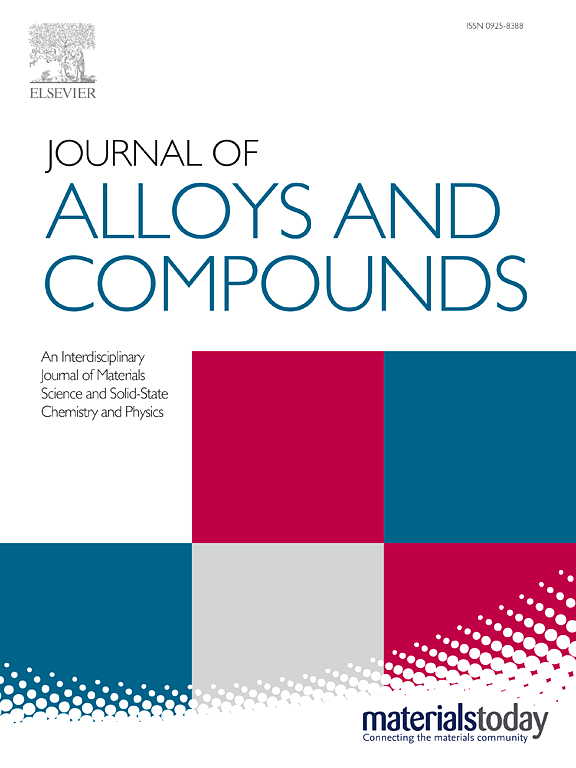Microstructural evolution and high-temperature wear resistance of novel TiC cermet coatings with CoCrFeNiMo0.1 high-entropy alloy binder fabricated by laser powders directed energy deposition
IF 5.8
2区 材料科学
Q2 CHEMISTRY, PHYSICAL
引用次数: 0
Abstract
The CoCrFeNiMo0.1 high-entropy alloy (HEAs)-coated TiC cermet powders, abbreviated as TiC@HEAs, were synthesized via spray granulation. Subsequently, CoCrFeNiMo0.1 coatings reinforced with varying contents of TiC@HEAs were fabricated using laser powder directed energy deposition (LP-DED). The microstructures of the LP-DED coatings consisted of unmolten TiC@HEAs particles, a transition region, and a (Ti, Mo)C precipitates region. As the content of TiC@HEAs increased, the TiC@HEAs particles gradually agglomerated, and the (Ti, Mo)C precipitates became coarser and more segregated. Furthermore, the hardness of the coatings significantly improved with increasing TiC@HEAs content at both room temperature and elevated temperatures. Specifically, at room temperature, the hardness increased from 201HV to 612–687HV; at 650°C, it increased from 178HV to 601–675HV; and at 850°C, it increased from 118HV to 528–510HV. The elevated-temperature hardness values indicate excellent high-temperature resistance. The coating containing 30 % TiC@HEAs exhibited the highest hardness and the best wear resistance at 650°C, with abrasive wear being the dominant wear mechanism. In contrast, the coating with 10 % TiC@HEAs demonstrated the highest hardness and good wear resistance at room temperature, with adhesive wear being the primary wear mechanism. Additionally, the incorporation of TiC@HEAs reduced friction. This study holds significant potential for expanding the high-temperature applications of HEA-based cermets, offering reliable solutions for manufacturing hot-rolled rolls, composite plates, and other heat-resistant materials.
激光粉末定向能沉积CoCrFeNiMo0.1高熵合金粘结剂新型TiC陶瓷涂层的组织演变及高温耐磨性
采用喷雾造粒法制备了CoCrFeNiMo0.1高熵合金(HEAs)包覆TiC陶瓷粉末(简称TiC@HEAs)。随后,采用激光粉末定向能沉积(LP-DED)法制备了不同含量TiC@HEAs的CoCrFeNiMo0.1涂层。LP-DED涂层的微观结构由未熔融的TiC@HEAs颗粒、过渡区和(Ti, Mo)C析出区组成。随着TiC@HEAs含量的增加,TiC@HEAs颗粒逐渐团聚,(Ti, Mo)C析出物变得更粗、更偏析。此外,在室温和高温下,随着TiC@HEAs含量的增加,涂层的硬度显著提高。在室温下,硬度由201HV提高到612-687HV;650℃时,从178HV升高到601 ~ 675hv;850℃时,从118HV升高到528-510HV。高温硬度值显示优异的耐高温性能。含30% TiC@HEAs的涂层在650℃时硬度最高,耐磨性最佳,磨损机制以磨粒磨损为主。在室温下,掺量为10% TiC@HEAs的涂层硬度最高,耐磨性好,磨损机制以黏着磨损为主。此外,TiC@HEAs的加入减少了摩擦。这项研究对于扩大hea基陶瓷的高温应用具有重要的潜力,为制造热轧轧辊、复合板和其他耐热材料提供可靠的解决方案。
本文章由计算机程序翻译,如有差异,请以英文原文为准。
求助全文
约1分钟内获得全文
求助全文
来源期刊

Journal of Alloys and Compounds
工程技术-材料科学:综合
CiteScore
11.10
自引率
14.50%
发文量
5146
审稿时长
67 days
期刊介绍:
The Journal of Alloys and Compounds is intended to serve as an international medium for the publication of work on solid materials comprising compounds as well as alloys. Its great strength lies in the diversity of discipline which it encompasses, drawing together results from materials science, solid-state chemistry and physics.
 求助内容:
求助内容: 应助结果提醒方式:
应助结果提醒方式:


